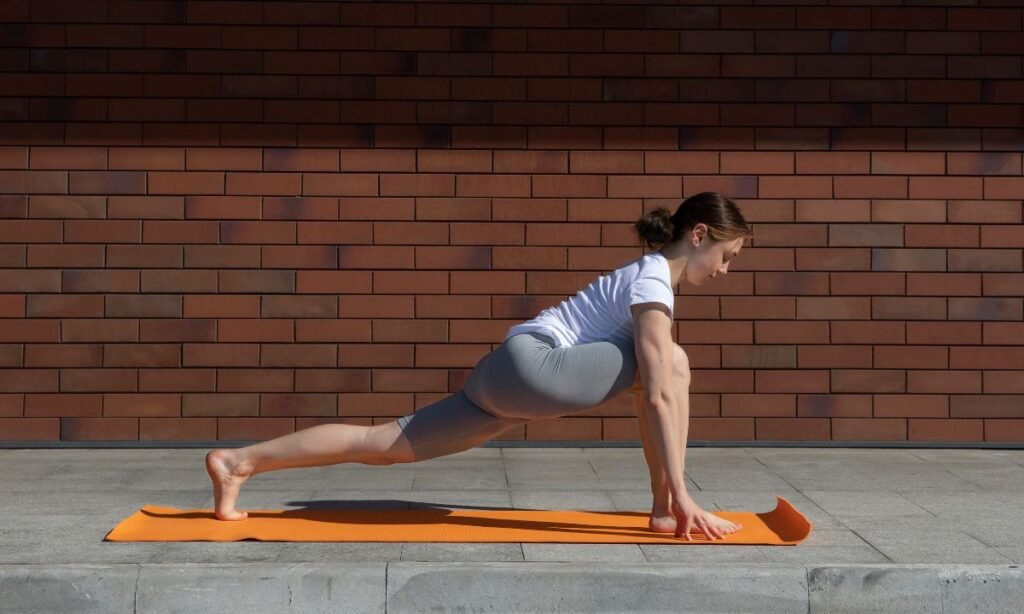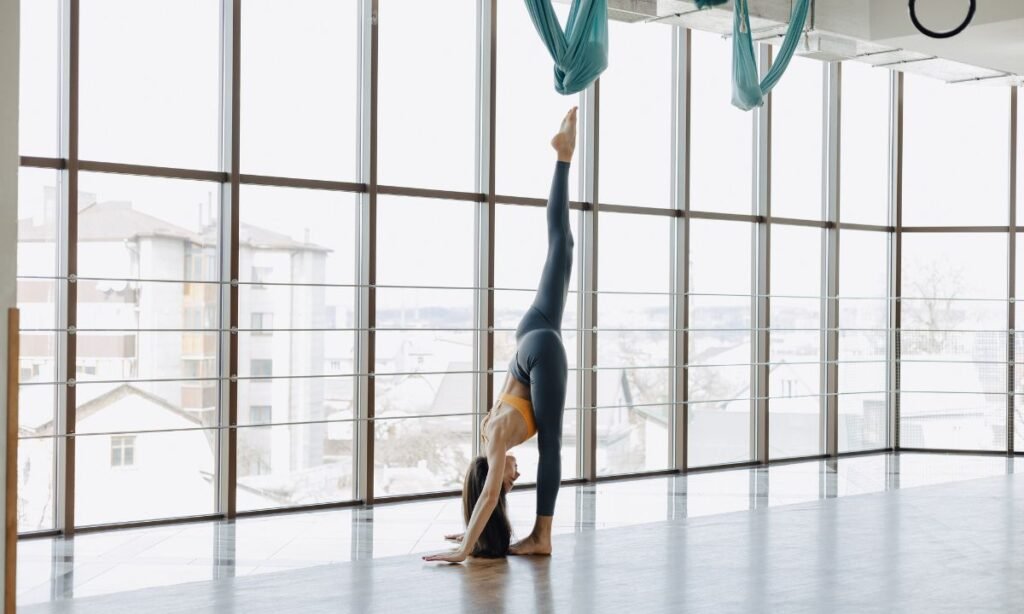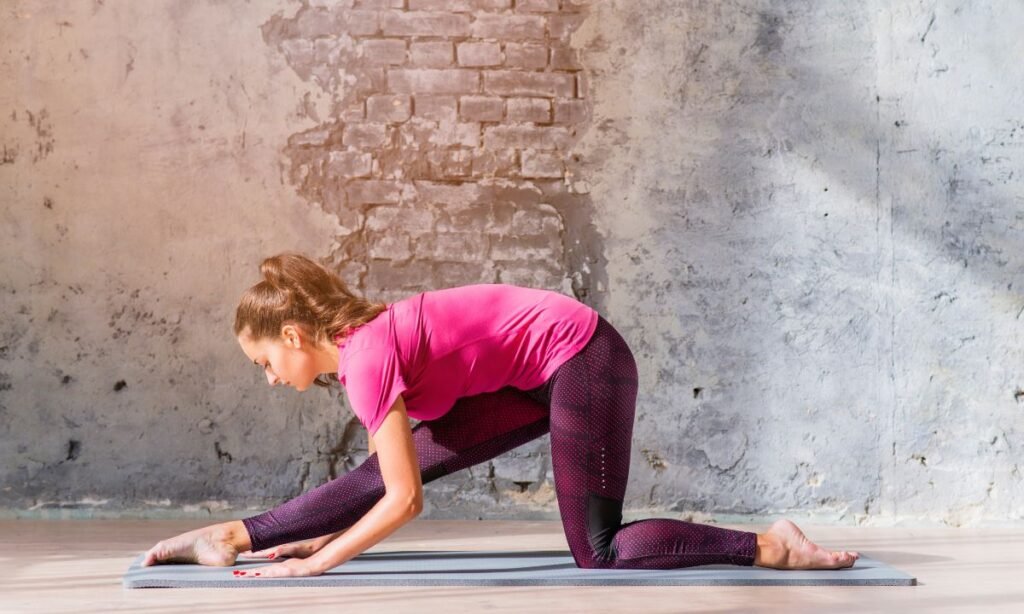Introduction: Meet Your New Favorite Stretch
Let’s be honest — we all spend too much time sitting. Whether you’re stuck behind a desk, driving your car, or binging your favorite shows, tight hips and stiff legs are all too common. But what if I told you there’s a simple yoga pose that can help you stretch, strengthen, and energize your whole body?
Say hello to the Runner’s Lunge Yoga Pose! Also known as Utthita Ashwa Sanchalanasana (don’t worry, there won’t be a quiz), this powerful pose is a must-know for both yogis and runners alike.
In this guide, you’ll learn everything about the Runner’s Lunge Yoga Position — from how to do it correctly, why it’s so good for you, to the sneaky mistakes most people make. Ready to loosen up and feel amazing? Let’s dive in!
What is Runner’s Lunge Yoga Pose?
The Runner’s Lunge Yoga Pose is a deep lunge that stretches the hips, legs, and back while building strength and balance. It mimics the motion a runner makes just before a race starts, hence the name. But don’t worry — you don’t have to be a runner to enjoy this stretch!
It’s often used in yoga flows as a transition pose, a warm-up, or even a cool-down stretch. You can think of it as a full-body wake-up call.
Step-by-Step: How to Do Runner’s Lunge Yoga Pose
- Start in a Downward-Facing Dog or from a standing position (Mountain Pose).
- Exhale and step your right foot forward between your hands.
- Make sure your right knee is stacked above your ankle. Your left leg stretches back with the toes pressing into the mat.
- Keep your hands on the floor or place them on yoga blocks for extra support.
- Draw your chest forward and engage your core.
- Hold this pose for 5-10 deep breaths.
- Switch sides and repeat!
Pro Tip: Smile! Your muscles will relax more when you do.
See also: Yin Yoga Sequence for Relaxation
See also: Top 10 Most Popular Yoga Poses for Strength & Flexibility
Benefits of Runner’s Lunge Yoga Pose
The Runner’s Lunge isn’t just a fancy stretch. It’s a full-body treat. Here’s why:
- Opens tight hips (goodbye desk-job stiffness!)
- Strengthens legs, glutes, and core
- Improves balance and stability
- Helps release tension in the lower back
- Prepares the body for more advanced yoga poses
- Boosts circulation and energy
It’s especially perfect if you run, cycle, or sit a lot during the day.
Mistakes in Runner’s Lunge (And How to Fix Them)
Mistakes happen, even to the best of us. Let’s fix the most common ones:
- Knee past the ankle: Oops! Keep the knee directly above the ankle to avoid strain.
- Hips too high: Lower your hips to deepen the stretch.
- Holding your breath: Remember to breathe! Inhale, exhale, repeat.
- Bent back leg: Keep the back leg active and straight to stretch the hip flexor properly.
Modifications and Variations for All Levels
Whether you’re a yoga newbie or a seasoned pro, you can adjust the Runner’s Lunge:
- Beginner-friendly: Drop your back knee to the mat and add a folded blanket under it for comfort.
- Advanced challenge: Lift your arms overhead, or twist your torso toward your front leg for a deeper core workout.
- Use props: Yoga blocks under your hands can make the pose more accessible and balanced.
When Should You Use Runner’s Lunge in Your Practice?
The beauty of the Runner’s Lunge is its versatility. You can add it to:
- Warm-up sequences
- Strength and balance yoga flows
- Cool-down routines after cardio or leg day at the gym
- Mid-day stretch breaks to fight that desk job fatigue
It’s one of those poses you’ll want to come back to again and again.
Runner’s Lunge Yoga Pose in Everyday Life
Here’s the fun part: this isn’t just a yoga pose. Doing the Runner’s Lunge regularly helps you move better in real life too.
- Picking things up off the floor? Less strain on your back.
- Running for the bus? Less tightness in your legs.
- Sitting all day? Say goodbye to hip pain.
Flexibility and strength aren’t just for the mat — they make everyday life easier and more comfortable.
See also: How to Do the Fallen Angel Yoga Pose with Ease
See also: Snake Pose Yoga (Sarpasana)
Safety Tips and Contraindications
A few friendly reminders before you jump into your new favorite stretch:
- Knee pain? Use a blanket under your back knee or skip the lunge entirely.
- Hip injuries? Modify the depth of your stretch.
- Lower back pain? Keep your core engaged and don’t overextend.
And of course, always listen to your body. If something feels off, ease out and try a gentler modification.
Conclusion: Why Your Body Will Thank You for Runner’s Lunge
Simple, powerful, and oh-so-satisfying — the Runner’s Lunge Yoga Pose is a total game-changer. Whether you’re stretching after a long run, warming up for your day, or cooling down post-workout, this pose will help you move better and feel better.
So roll out your mat, step forward, and give those hips the love they deserve. Your body (and your future self) will thank you!
See also: Halfway Lift Pose: Master the Half Standing Forward Bend
See also: Wind-Relieving Pose: Boost Digestion & Ease Bloating Fast
Frequently Asked Questions
Q: What muscles does Runner’s Lunge stretch?
A: It stretches your hip flexors, hamstrings, calves, and lower back while strengthening your legs and core.
Q: Can beginners do the Runner’s Lunge Yoga Position?
A: Absolutely! Use a blanket or yoga blocks for extra support until you feel comfortable.
Q: How long should I hold the Runner’s Lunge Stretch?
A: Anywhere from 5 breaths to 2 minutes per side, depending on your goal (stretching vs. strengthening).
Q: Can Runner’s Lunge help with back pain?
A: Yes, if tight hips or weak glutes are contributing to your back pain, this pose can help. Always practice mindfully!
Q: What’s the difference between Runner’s Lunge and a regular lunge?
A: Runner’s Lunge focuses more on stretch and alignment, while a regular fitness lunge focuses more on building muscle and strength.

Salman is a passionate yoga teacher with over 8 years of experience in the world of yoga and wellness. Through his articles, he shares insights, tips, and practices to help others deepen their yoga journey. For inquiries, reach out at Contact@yogamelt.com.




